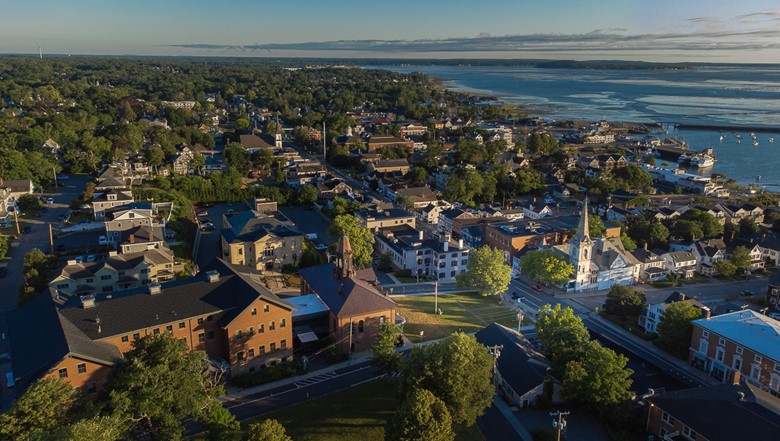Everyone can agree that Plymouth’s precarious aquifer, which supplies the town’s drinking water, needs to be protected. But local activists warn that an increasing number of industrial, commercial, and residential development projects, as well as sand-mining operations, are putting the quality of our water at increasing risk.
Town officials say they are trying to strike a balance between maintaining water quality and Plymouth’s need for more housing and commercial development. And they note that Plymouth’s water quality meets standards set by the state’s Department of Environmental Protection.
Still, they acknowledge that the water supply is fragile, and that constant vigilance is needed. “Plymouth finds itself in a delicate balancing act that we take very seriously,” said Town Manager Derek Brindisi.
But not seriously enough, according to some local environmental activists.
Plymouth draws its drinking water from a 199-square mile aquifer that lies under Plymouth, Carver, and other nearby towns.
In 1990, the US Environmental Protection Agency designated the town’s water supply as a “sole-source aquifer,” providing 100 percent of Plymouth’s drinking water and a significant percentage to seven neighboring towns. By definition, a sole-source aquifer means there are no alternate drinking water sources.
The aquifer lies just beneath ground level. Trees, vegetation, wetlands, and sand on the surface provide natural protection and filtration. “All our wells are like straws that drink from the same aquifer” is one metaphor heard from both activists and town officials.
“We must raise awareness of serious concerns over water quality, water supply, and conservation,” said Katherine Harrelson, an environmental scientist and member of the nonprofit Community Land and Water Coalition. “How much water do we have, where does it come from, will it accommodate reasonable growth, and can we maintain good water quality?”
Plymouth’s Water Division supplies drinking water to about 44,000 of the town’s 61,000 residents, said Peter Gordon, the division’s superintendent, though the total population number is outdated. The Water Division relies on 13 major wells, located from the Carver line in West Plymouth to Cedarville, he said. (In addition, about 4,000 homes and businesses in the downtown area are also hooked into town sewer service.)
Other residents tap into the water supply from private wells and community wells serving the Pinehills, Redbrook, and Ponds of Plymouth developments, Gordon said. While these residents’ drinking water wells might be on private property, the state considers them public water supply sources.
Activists Harrelson and Meg Sheehan, an environmental attorney and a member of the nonprofit Community Land and Water Coalition, said residential development can be done in a way that preserves vegetation and topsoil and is built within existing topography without the need for sand and gravel removal.
Lee Hartmann, the town’s director of planning and development, said development projects are crucial to the town’s economic stability.
“There are tradeoffs between prohibiting commercial development and allowing it along with the jobs and taxes that such uses bring to the town,” he said. “We continue to hear concerns about the residential tax burden and are always looking at ways to offset that burden. The town has very little commercial land remaining. Maximizing the use of the limited amount of commercial land is a town priority.”

Brindisi pointed to what he called Sheehan’s “overreach” after she and others in 2022 pushed against the proposed over-55 Claremont development at Colony Place. The frustrated developer has opted instead to move forward with a 40B development, allowed in any Massachusetts community with less than 10 percent of its housing deemed affordable. It allows developers to bypass certain regulations in the interest of increasing affordable housing stock.
“As a result, the developer will construct a much larger and taller development, adding to traffic woes and placing strains on schools,” Brindisi said.
He said that town boards would prefer to collaborate with local activists, rather than fight with them.
Some activists, however, question whether their concerns are being seriously considered.
Sheehan said that for decades the town has been pushing more development as the only way to reduce real estate taxes, a plan she says has not worked. Brindisi, she said, “deflects attention from the issue of protecting our water by throwing up the specter of 40B. The 40B project he refers to is not materially different from what the Claremont developer originally proposed.”
For his part, Hartmann insists that the town has rigorous standards in place to protect the aquifer. “Our bylaw standards…are designed to ensure safe drinking water for the town,” he said. That bylaw includes a lengthy list of prohibited land uses which would require a special permit from the Zoning Board of Appeals, he said.
Plymouth tests its water supply annually and issues public reports on the findings – most recently in the 2023 Annual Water Quality Report. The federal Environmental Protection Agency said that Plymouth’s test results from its 2023 report showed no violations of water quality standards.
The Massachusetts Department of Environmental Protection (DEP) also sets standards on water- quality contaminants. Its Environmental Working Group warns that because federal EPA standards are not up to date, they may not protect public health.
The Environmental Working Group’s website allows people to enter the zip code of any community in Massachusetts to obtain immediate information on levels of contaminants. For Plymouth, it found five contaminants within the legally allowed limit. For six other found contaminants, the DEP has not established legal limits.
How many PFAS contaminants, known as “forever” chemicals, does Plymouth test for? Peter Gordon, superintendent of the town’s Water Division, said it follows federal EPA methods for analyzing 29 such compounds in drinking water. All sampling results have been below the maximum contaminant levels set by the state DEP, he said.
But that’s not good enough to ensure safety, according to Don Williams, president of Plymouth’s Herring Ponds Watershed Association and co-chair of its water-quality committee. PFAS chemicals appear in everything from dental floss to consumer packaging. Williams, a retired chemist, has a doctorate degree in organic chemistry.
Beyond the subject of PFAS, Williams said poorly functioning private septic systems can allow contaminants to seep into ourdrinking water. Also, Williams said the clear cutting of trees by homeowners who live around Plymouth’s many ponds can also jeopardize our water supply through water runoff. With the aid of David Gould, director of the town’s Department of Energy and Environment, the Herring Ponds Watershed Association will soon install a permeable reactive barrier in a stream that feeds that watershed, in attempt to curb harmful contaminants, Williams said.
Garrett Tunison, a scientist at Tunison Environmental Consultants in Plymouth, says many private septic systems’ leaching fields do not filter out contaminants before penetrating and polluting aquifers.
Tunison is pleased that the DPW is pursuing a tertiary approach to treating wastewater at its centralized Camelot Drive plant to reduce non-biodegradable pollutants. Treated water is then fed into the Eel River and other tributaries, where it winds its way into Plymouth Harbor. However, Tunison warned, “I hope that Plymouth doesn’t take a short-sighted approach like other towns. It’s much better to site multiple treatment plants throughout the town in critical locations. This is a much more expensive approach, but much cheaper and much more effective in the long term.”

What are the greatest concerns to Plymouth’s aquifer, according to the Community Land and Water Coalition and the Southeastern Massachusetts Pine Barrens Alliance?
Several large-scale development projects that include sand mining. Activists cited as an example the 19-acre development site off Route 3 within the Plymouth Industrial Park. Owner and developer Scott Spencer has received a permit to remove 488,000 cubic yards of sand and gravel. Plymouth’s planning board chairman at the time that the project was approved noted, “The more we dig the more we pollute our water.”
In addition, the Claremont complex being built at Colony Place will be tied into Plymouth’s municipal wastewater system, town officials said.
Hartmann said Plymouth recently updated its Earth Removal Bylaw, which includes other towns’ best practices and was formulated with input from environmental activists. “We also heard from experts that Plymouth’s highly permeable sandy soils provide limited protection to our aquifer,” he said. “But simply prohibiting all gravel removal is not an answer.”
Commercial development. For example, the Planning Board approved an auto dealership with an adjoining car wash near Colony Place, said Harrelson, the Community Land and Water Coalition member. “The car wash sited was cleared of trees and built in a Zone II protected for a town well,” she said. “Its approval has allowed for the dangerous clear-cutting of trees.”
In response, Hartman again cited the need for “a balance between no development anywhere in town and allowing commercial development with the jobs and tax revenue it produces in the limited commercially zoned land.” He said the auto dealership “went through an extensive review process and the Zoning Board of Appeals imposed 23 conditions on the development. Conditions relate to aquifer protection, stormwater quality and groundwater monitoring.”
But according to Sheehan and other activists, improperly regulated clear cutting of trees and sand mining often remove topsoil that filters and protects the aquifer,
“Over the last 15,000 years, tree roots and vegetation have helped to prevent soil erosion, serving to capture contaminants before they can reach our underground aquifer,” she said. “Trees absorb nitrogen and phosphorous and slow down stormwater runoff. Anything that enters surface water can enter groundwater.”
“A direct connection exists between surface water and groundwater, which is why it’s so important to leave soil and forests in place, where possible,” Sheehan said. “Otherwise, we will be faced with the exorbitant costs of cleaning up and filtering our water with treatment plants.”
Failing private septic systems that leach contaminants into the aquifer and ponds. Plymouth officials said that town departments continue to seek funding to defray the cost for homeowners to upgrade their septic systems to pass required state Title V inspections. An inspection looks at the system’s septic tank, distribution box, and leach field. “A properly functioning septic system does not pollute groundwater,” said Plymouth Public Health Director Karen Keane.
How can residents get involved with drinking-water protection?
- Attend town meetings such as the Select Board, Planning Board, Open Space, Energy, and Conservation, and make your concerns known to the town.
- Considering joining a town committee.
- Read or skim this report published by the Plymouth Board of Health, which is responsible for protecting drinking water.
- Join the Old Colony Planning Council water supply study committee.
Steven Feldman is a real estate agent for Keller Williams Realty, a renovator of Plymouth-area properties, and a former Boston journalist.

